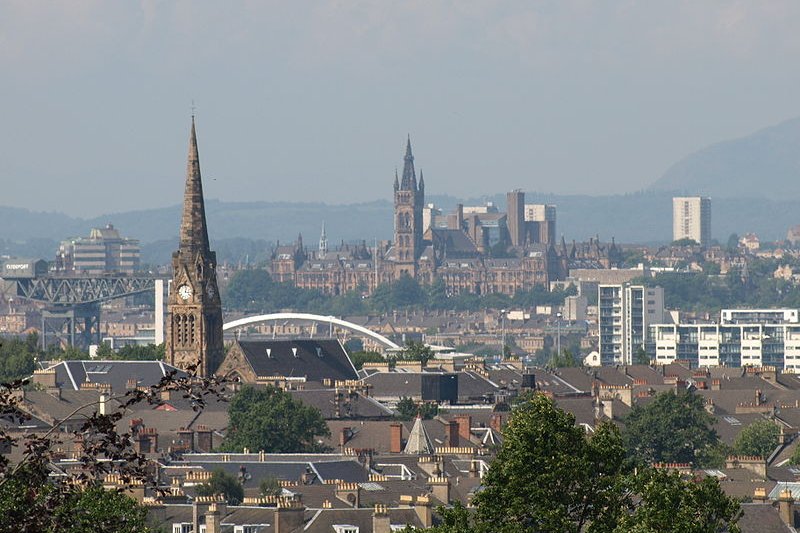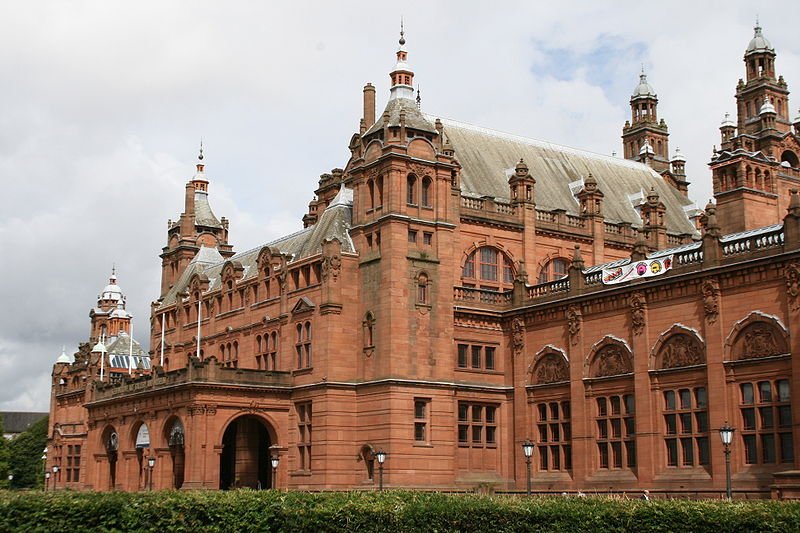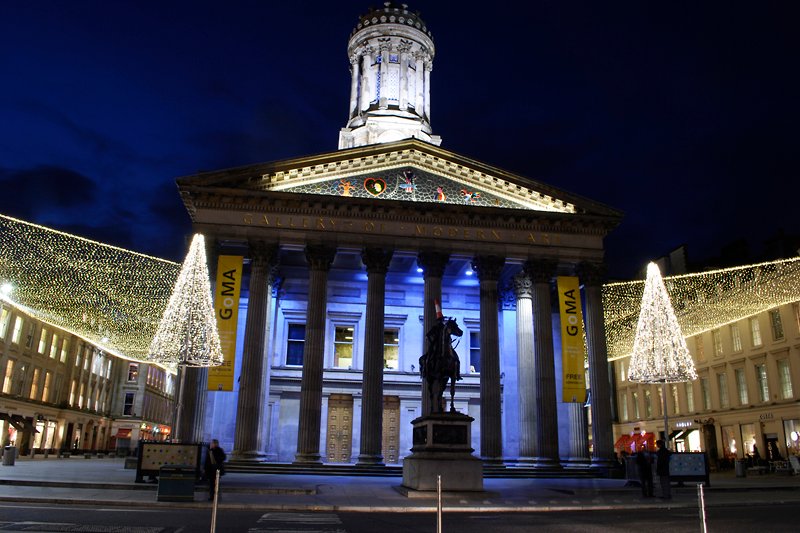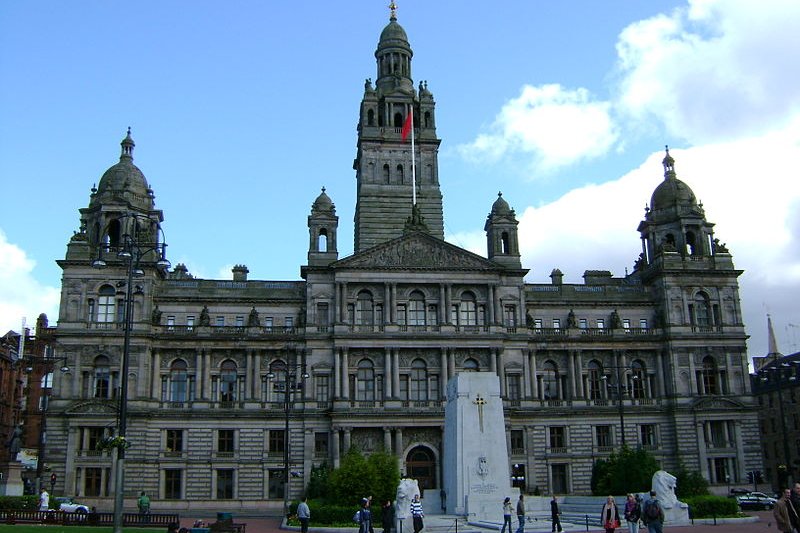 Glasgow, Scotland
Glasgow, ScotlandSource: https://commons.wikimedia.org/wiki/File:View_of_Glasgow_from_Queens_Park.jpg
Author: John Lindie

Glasgow is the biggest city in Scotland. It has an urban population of 580,000 with the total metropolitan population of 2.3 million people.
As with many towns in Britain, Glasgow traces its beginnings to prehistoric times. By the 10th century, the settlement of Glasgow has become the site of the second largest bishopric in Scotland. The Glasgow Fair that is still celebrated today dates back to the annual fair that began in the early 12th century.
The town of Glasgow became firmly established with the founding of the University of Glasgow in 1451, and the elevation of the bishopric to an archbishopric in 1492. Glasgow also benefited from the Acts of Union of 1707, which merged the Kingdoms of England and Scotland, effectively opening access for Scotland to the vast market of the British Empire.
 Kelvingrove Museum, Glasgow
Kelvingrove Museum, GlasgowSource: https://commons.wikimedia.org/wiki/File:Glasgow-kelvingrove-museum-1.JPG
Author: Thyes

In the 18th century, Glasgow was the industrial center for Scotland, producing textiles, chemicals and manufactured goods. By the 19th century, it surpassed Edinburgh as the biggest city in Scotland.
The fortunes of Glasgow waned in the early decades of the 20th century, as it suffered through post-World War I recession and the Great Depression. It enjoyed a post World War II boom through the 1950's, but by the 60's, its economic growth has again petered out. There followed two decades of economic stagnation and high unemployment.
A turnaround in the city's economy came in the late 1980's as Glasgow assumed a new role as Europe's center for business services and finance. A string of activities further boosted the city's economy and it's people's morale.
Glasgow hosted the Glasgow Garden Festival in 1988 and was bestowed the title of European City of Culture in 1990. Large scale redevelopment took place in the city, among them the Clyde Waterfront Regeneration project. Nonetheless pockets of social deprivation still exists, particularly on the eastern part of the city, and unemployment rates continue to be higher than other major cities in the United Kingdom.
Going to Glasgow
By PlaneGlasgow International Airport (GLA) is located 14 km to the west of downtown. Budget travelers arriving there can take the Arriva 500 shuttle bus to the Glasgow Railway Station in the city center. The journey takes 20 minutes, and the fare is £4.20. Alternatively, the slower and less frequent First 747 shuttle costs only £4.
Even slower still, and more economical, is to take local bus No. 66. It goes to the Paisley Gilmour Street railway station, from where you can take a commuter train to Glasgow Central. First you buy a £1.50 coupon from the SPT Travel Information counter at the Domestic Arrival Hall. Show it to the bus driver to get a £1.50 credit to off-set the train ticket. The whole journey costs £2.75, or £1.80 if you are holding a National Rail railcard.
By Train
If you are coming from London and other cities south of Glasgow, you arrive at the Glasgow Central railway station. Trains from Edinburgh and cites north of Glasgow arrive at the Queen Street station. Both stations are just 10 minutes walking distance from each other. There's a shuttle bus going between these station. It is free if you hold a train ticket.
Trains to Glasgow leave London's Euston Station, taking between 4 hours 10 minutes (express) to 4 hours 32 minutes (regular) to reach Glasgow Central.
 Gallery of Modern Art, Glasgow
Gallery of Modern Art, GlasgowSource: https://commons.wikimedia.org/wiki/File:GoMARoyalExch.jpg
Author: DannyHearn

Going around Glasgow
Downtown Glasgow is reasonably compact and can be explored on foot. The downtown area comprises City Centre and West End. City Centre is where you find much of the shopping and entertainment of the city. At West End are cafés, restaurants and bars.Glasgow has a subway system. It comprises two lines that loop the city, one clockwise and the other anti-clockwise. The fare is £ 1.20 per ride, or you can buy a daily pass for £3.50 for unlimited rides.
 Glasgow City Chambers
Glasgow City ChambersSource: https://commons.wikimedia.org/wiki/File:Glasgow_City_Chambers,_Glasgow.jpg
Author: Kilnburn
Places of Interest in Glasgow
- Glasgow Cathedral
One of the few cathedrals in Scotland to escape the Scottish Reformation - Clyde Auditorium
Concert hall designed by Sir Norman Foster. - City Chambers
Headquarters of the Glasgow City Council, housed in an 1888 Italian Renaissance building. - Mitchell Library
Largest municipal public reference library in Europe. - St Mungo Museum of Religious Life and Art
Museum exhibiting religious themes through artifacts. - Tenement House
Museum offering a glimpse of life in a Glasgow flat of the early 20th century. - Provand's Lordship
The oldest surviving house in Glasgow. - Willow Tea Room
The only remaining tea room by Charles Rennie Mackintosh - Museum of Transport
Museum that exhibits the engines and vehicles of the early 20th century. - People's Palace
19th century sandstone building housing the cultural museum of the people of Glasgow's East End. - Glasgow School of Art
An art school designed by Charles Rennie Mackintosh. - Hunterian Art Gallery
Gallery housing the largest print collection in Scotland. - Kelvingrove Art Gallery and Museum
A stricking Glasgow landmark of red sandstone that is the most visited gallery and museum in Scotland. - Pollok House
The finest 18th-century domestic building in Glasgow. - The Burrell Collection
A purpose-built gallery with internationally acclaimed collection of objects covering numerous fields of interest.
 Latest updates on Penang Travel Tips
Latest updates on Penang Travel Tips
 Map of Roads in Penang
Map of Roads in Penang
Looking for information on Penang? Use this Map of Roads in Penang to zoom in on information about Penang, brought to you road by road.
Copyright © 2003-2025 Timothy Tye. All Rights Reserved.

 Go Back
Go Back